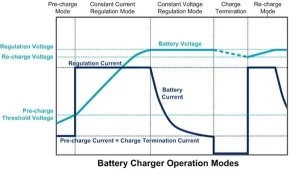With the advent of fast charging technology, users often wonder which is better: slow charging vs fast charging. In this comprehensive guide, we will delve into the charging process of lithium batteries, explore the benefits and drawbacks of both fast and slow charging methods, highlight the critical differences between them, and ultimately determine which approach is better for your precious lithium battery.
Part 1. The charging process of lithium batteries

Before diving into the comparison between fast and slow charging, it’s essential to understand the fundamental charging process of lithium batteries. Lithium-ion (Li-ion) batteries, commonly found in smartphones, laptops, and other portable devices, transfer lithium ions between the positive and negative electrodes during charging and discharging cycles.
When a lithium battery is charged, ions flow from the positive electrode (cathode) to the negative electrode (anode) through an electrolyte. This process is reversed during discharge, as the ions move from the anode to the cathode, generating the electrical energy required to power our devices. It’s crucial to ensure a balanced and controlled charging process to maintain the longevity and performance of the lithium battery.
Part 2. Fast-charging lithium batteries

Fast charging has revolutionized how we recharge our devices by significantly reducing the time required to replenish battery life. This charging method utilizes higher current levels to expedite the charging process. With fast charging, it’s possible to charge a lithium battery from 0% to a considerable percentage in minutes. However, it’s important to note that not all lithium batteries are compatible with fast-charging technology.
Pros:
One of the critical advantages of fast charging is the time-saving aspect. It allows users to quickly recharge their devices and return to using them without extended downtimes. Moreover, fast charging can be particularly beneficial in emergencies or when you’re on the go and need a quick power boost.
Cons:
Fast charging does have its drawbacks. The higher current levels during fast charging generate more heat, adversely affecting the battery’s overall health. Excessive heat can lead to increased battery degradation, reducing capacity and lifespan. Additionally, fast charging may cause more significant voltage fluctuations, potentially impacting the stability and safety of the charging process.
Part 3. Slow-charging lithium batteries
Slow charging, or trickle or conventional charging, is the traditional method of recharging lithium batteries. It involves using lower current levels and longer charging times than fast charging. Slow charging is often considered safer and more gentle, allowing the battery to charge gradually without exposing it to excessive heat or voltage fluctuations.
Pros:
One of the primary advantages of slow charging is its ability to minimize stress on the battery. The slower charging process helps maintain a lower temperature, reducing the risk of overheating and potentially damaging the battery cells. Slow charging is especially recommended for older or degraded lithium batteries, as it provides a more controlled and gentle charging experience.
Cons:
Slow charging does come with the trade-off of longer charging times. If you’re in a hurry or constantly moving, there may be better options than waiting for your battery to charge fully. Moreover, some newer devices may not support slow charging or lack the necessary compatibility for this method.
Part 4. What is the difference between slow charging and fast charging for lithium batteries?
Charging Time
Fast charging significantly reduces charging times compared to slow charging. While slow charging may take several hours to reach a full charge, rapid charging can replenish a considerable percentage of the battery in minutes.
Battery Longevity
Slow charging is more favorable for lithium batteries’ long-term health and lifespan. The slower charging process minimizes heat generation and reduces battery stress, helping maintain its capacity and overall performance over time.
Compatibility
Not all devices or lithium batteries support fast charging. It’s essential to check the manufacturer’s specifications or consult the device’s user manual to ensure compatibility with fast charging technology.
Safety
Fast charging can generate higher heat levels and voltage fluctuations, potentially compromising the safety and stability of the charging process. Slow charging, on the other hand, offers a more controlled and gentle charging experience, prioritizing safety.
Convenience
Fast charging provides the convenience of quickly replenishing battery life, making it suitable for users who are always on the go or need emergency power. Slow charging requires more patience and planning due to longer charging times.
Part 5. Conclusion
There are several factors to consider regarding fast charging vs. slow charging for your lithium battery. Fast charging offers the convenience of quick power replenishment. Still, it may increase heat generation and cause battery degradation over time. On the other hand, slow charging is a safer and more gentle approach that prioritizes battery longevity but requires longer charging times. Ultimately, the choice depends on your specific needs, device compatibility, and concerns about battery health.
Part 6. FAQs
-
Why is my fast charger charging slow?
Possible reasons include incompatible chargers, multiple devices charging simultaneously, low-quality charging cables, or power-related background processes. -
Does fast charging affect battery life?
Fast charging can impact battery life due to increased heat generation, but modern devices have safety mechanisms to minimize damage. -
Is fast charging wrong for lithium batteries?
Fast charging is not inherently wrong; higher heat generation can affect battery health. Responsible use and following guidelines are essential. -
Is slow charging always safer than fast charging?
Slow charging is generally considered safer due to its lower heat generation and gentler charging process. However, it’s crucial to use high-quality chargers, follow manufacturer guidelines, and avoid charging your device in extreme conditions to ensure safe charging regardless of the method. -
Which charging method is better for battery longevity?
Slow charging is generally better for battery longevity as it reduces heat generation and stress on the cells. However, using fast charging occasionally and following safe charging practices should not significantly impact battery longevity.
Related Tags:
More Articles

Overview of Deep Cycle Lithium Battery
In this article, we explore the life, voltage, capacity, and charging considerations of deep cycle lithium batteries.
How Long do Lithium Batteries Last?
How long do lithium batteries last? we will explore the factors that influence the lifespan of lithium batteries and provide insights into their longevity.
How to Choose the Best LiFePO4 Battery?
Choose LiFePO4 batteries for superior performance, safety, and versatility in EVs, UPS, and backup power. This guide helps you make informed decisions.
Get 12v Lithium Car Battery As a Power Source for the Ride
Make the right choice for your vehicle's battery needs by installing a 12 volt lithium car battery. You will enjoy maintenance-free longevity with this change.
Everything About A Small Lithium Ion Battery
Discover the features, uses & future potential of a small lithium ion battery. A compact and tiny powerhouse ideal for smartphones, wearables, drones & more.





